
The Auxois is a horse breed from eastern France. It is a large breed, with some individuals weighing over 910 kilograms (2,010 lb), bred for horse meat, agricultural work and leisure pursuits. Overall, members of the breed are solid and muscular in appearance. They are usually bay or bay roan in color, although some other colors are accepted by the breed registry, and are known for their power and docility.
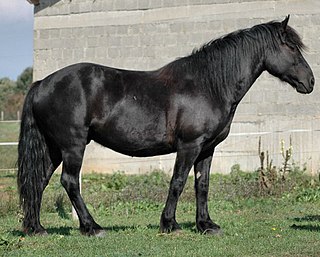
The Mérens, Cheval de Mérens or Caballo de Merens, still occasionally referred to by the older name of Ariégeois pony, is a small, rustic horse native to the Pyrenees and Ariégeois mountains of southern France, where the river Ariège flows, and northern Spain, near Andorra. Two general types, a small, light traditional mountain horse and a taller, sportier modern type, are found. Always black in color, Mérens must meet strict physical standards in order to be registered in the stud book. The breed is known for its sure-footedness on mountain terrain, as well as for its endurance, hardiness and docility. The French breed registry organizes regional offices, and partners with other national organizations in Europe to preserve and promote the breed. The organization enforces rigorous selection of breeding stock, with a goal of increasing quality in the breed. In the past, the Mérens was used for farm work, draft work and as pack horses. Today it is mainly used as a saddle horse, although some members of the breed have been successful in carriage driving. Many Mérens are taken on an annual transhumance, in which they are moved higher in the mountains during the summer and into the valleys for the winter. An old practice, it fell into disfavor, but has recently re-emerged.

The Java pony is a breed of pony developed on the island of Java in Indonesia. It is thought to have descended from wild forebears of Mongolian Wild Horse ancestry. It is larger and stronger than the Timor pony, with more Arabian breed influence.

The Gayoe, also known as the kuda-Gayo, is a pony from the island of Sumatra, found near Aceh. The name is derived from the Gayoe hills in the north of the island.

The Anglo-Norman horse is a warmblood horse breed developed in Lower Normandy in northern France. A major center of horse breeding, the area had numerous regional types that were bred to one another and then crossed with Thoroughbreds to form the Anglo-Norman. Various body types developed within the Anglo-Norman breed, two of which were split off to form the Norman Cob and French Trotter. The remaining types were eventually standardized, although there remained some criticism of the "hybrid" nature of the breed's conformation. However, it is successful as an international sport horse, especially in the sport of show jumping. The Anglo-Norman also contributed to the development of several other breeds in Europe and Asia.
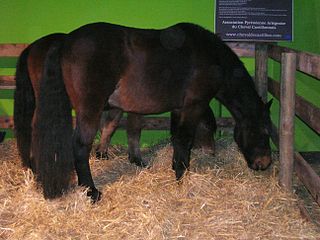
The Castillonais or Cheval Ariègeois de Castillon , also formerly called Cheval du Biros or Saint-Gironnais, is an ancient breed of small rustic saddle-horse from the Ariège département of south-western France. It may be dark bay or seal brown. It stands 135–155 centimetres at the withers, with an average height of about 145 cm. It is used principally for trekking and for driving.

The Henson Horse, or Cheval de Henson, is a modern horse breed from northeast France. It was created by the selective breeding of light saddle horses with the smaller, heavier Norwegian Fjord horse to create small horses suitable for the equestrian vacation industry. The breeders' association, Association du Cheval Henson, was formed in 1983. In 1995 the studbook was closed to horses not born from Henson parents, and in 2003 the breed was officially recognised by the French government agencies for horse breeding. A hardy breed of horse, each winter the broodmares and youngstock from several breeders are let loose together to graze freely in the wetland reserves in France.

The Bidet was a type of small horse from France, now extinct. It was a landrace developed principally in the area around Brittany, Morvan, Auvergne, Poitou, and Burgundy. It stood about 110–135 centimetres at the withers. Two distinct groups are documented, which were bred in a semi-feral state.

Marine Oussedik, born on May 20, 1967, is a painter, sculptor and an illustrator specialized in horses. In 1990, she graduated from ESAG Penninghen, the Higher College of Graphic Arts, and started exhibiting in Parisian galleries the following year. Immediately afterwards she was commissioned paintings by the Living Museum of the Horse in Chantilly to be permanently displayed in two rooms. At the same time she published a book, Les chevaux d'encre. Many art books would follow including Les chevaux du Sahara in 1998, Les chevaux du vent in 2002 and Les chevaux de rois in 2003. She would be rewarded by Prix Pégase for those last two books which testify to her passion for illustrations of all kind of horses, Arabians being her favorite. In 2014, she illustrated an art book dedicated to classical French riding with texts by Guillaume Henry.
Horse cloning is the process of obtaining a horse with genes identical to that of another horse, using an artificial fertilization technique. Interest in this technique began in the 1980s. The Haflinger foal Prometea, the first living cloned horse, was obtained in 2003 in an Italian laboratory. Over the years, the technique has improved. It is mainly used on high-performance but castrated or infertile animals, for reproductive cloning. These horses are then used as breeding stock. Horse cloning is only mastered by a handful of laboratories worldwide, notably in France, Argentina, North America and China. The technique is limited by the fact that some differences remain between the original and its clone, due to the influence of mitochondrial DNA.

The Miquelon horse is a horse breed in the process of being characterized, established on the Saint Pierre and Miquelon archipelago (France), near the east coast of North America. It is similar in origin to the Newfoundland pony, and is probably descended from imported French horses, later influenced by the Clydesdale, Quarter Horse and Appaloosa. Moreover, it is closely related to the Canadian horse, from which it differs in size. The Miquelon, only having been studied since 2007, lives in semi-freedom outdoors during the warm season, and is mainly used as a trail riding horse.

Haguard horse, also known as the Hague pony or bidet de la Hague, is a breed of bidet horse native to the natural region of La Hague, in the Manche in Normandy.
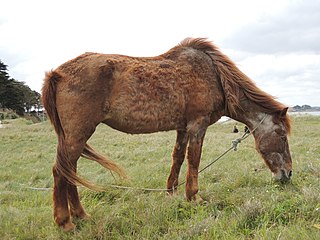
A geriatric horse is an equine that has a physical and mental decline, which generally prevents it from being used for most equestrian activities. The age of a geriatric horse could vary according to breed and riding use, with old age occurring more rapidly in Thoroughbred sport horses than in hardy ponies. Geriatric horse signs include tooth eruption, whitening of certain areas of the head, arching of the back and stiffness of locomotion. The animal also becomes more sensitive to the passing of the seasons.

The Barraquand horse is a French mountain horse breed. It is the result of an ancient selection process in the Vercors Massif, and it may have originated from a small herd of animals selected by religious communities, notably those established in the Léoncel abbey. It takes its name from the Barraquand family, who developed their breeding from the late 19th century to the 1950s, thanks to the practice of transhumance. Considered lost after the bankruptcy of the original Barraquand breeding operation and the sale of part of their land in 1963, the breed has been reconstituted since the 1990s, thanks to the initiative of several breeders and local institutions, in particular the Barraquand family, the Vercors Regional Natural Park and the Annecy National Stud.

The horse body mass is highly variable, depending on breed, model, physiological state, condition, owner's purpose and usage of the animal. Always 65 % to 75 % water, it is divided on average between 50 % muscle, 11 % bone and 10 % fat. Depending on whether it's a pony or a draft horse, it can range from less than 200 kg to over a ton, with an average of 500 kg for saddle horses. It also differs with the season, as horses are almost always fatter in summer than in winter. Various tools are used to estimate their weight and body condition, and veterinary scales have been created to determine whether a horse has an ideal body mass according to precise criteria. Thinness is associated with mistreatment, but owner-independent factors such as age and illness can cause dramatic weight loss in horses. In Western countries, equine obesity is one of the major veterinary health problems of the 21st century. It is directly linked to numerous pathologies, such as laminitis, osteoarthritis, insulin resistance and colic. It also favors the development of equine Cushing's disease, and causes a drop in stallion fertility.
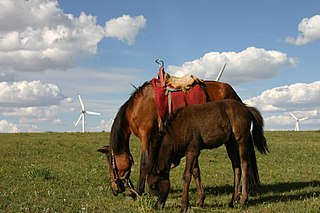
The Chinese Mongolian is a breed of horse, corresponding to the population of Mongolian horses that remained in China after Mongolia's independence in 1910. Possibly descended from Przewalski's horse, it has been domesticated since ancient times. In 1982, they accounted for a third of all horses in China. Since then, their numbers have declined sharply, under the influence of mechanized transport and modern lifestyles.
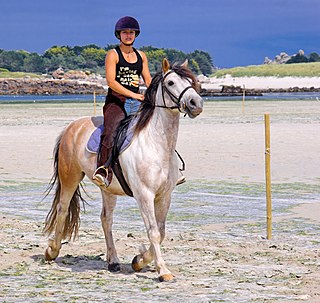
Leisure horses are intended for pleasure riding, and in particular for trail riding by private individuals. Difficult to define, it is above all an animal endowed with particular qualities, rather than a precise breed. It must be versatile and calm in character, with a willing and courageous mind. As early as the 1970s, breeders such as those of the Swiss Freiberger or Franches-Montagnes were breeding animals for this then-new use. The market for leisure horses is now buoyant. France has created "leisure qualifications" for this purpose.

The Ujumqin is a type of Chinese Mongolian horse. Larger and reputedly better conformed than other horses of this breed, it is mainly ridden, the mares being milked for their milk.

The Amourski, also known as Amur horse or Manchurian pony, is an extinct breed of small Siberian and Manchurian horses. Formed in the early 19th century, it originated from the area around the Amur River in northeast Asia, in Russia and China. These small horses, more refined than other Siberian breeds, were usually ridden or driven, and were known for their hardiness.

Equestrianism is the third most popular Olympic sport inFrance, and the leading sport for women.

























